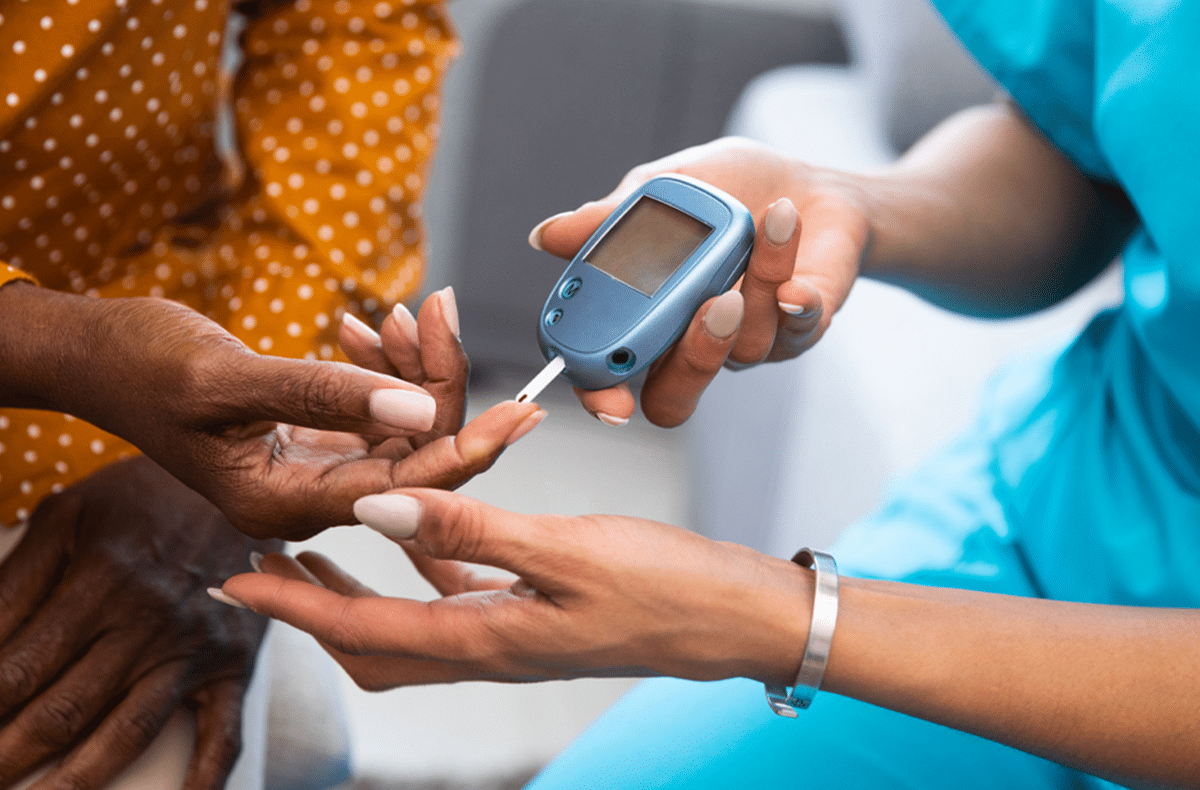How to lead a healthy life with diabetes

About 422 million people worldwide have diabetes. It can do serious damage, but it can also be managed and doesn’t have to turn your life upside down.
A few weeks ago, Thumelo Vuka went to the doctor. “My stomach hurt nearly all the time,” he says. “I was sent for fasting blood tests and came back with a diabetes type 2 diagnosis.”
He felt angry at first. “Only 10 per cent of diabetics have type 1 and they were mostly born with it,” he explains. “But with type 2, you feel that you brought this on yourself. I take pride in cooking healthy meals. I have a bit of a tummy, but I’m not seriously overweight. I don’t even drink. And though I slacked off with exercise during lockdown, I am on my feet a lot of the day.”
CAUSES
Lack of exercise, being overweight and high blood pressure can cause type 2 diabetes. But it’s not all your fault. There can be a tendency for those who are overweight, and if diabetes is in your family genes, the risk increases if you’re over 45.
Visceral fat, or belly fat, is a serious problem that affects the liver’s workings and does other damage that’s still being researched.
You can be quite thin and still have too much visceral fat. A simple way to check is by measuring your waistline. You are at higher risk of Type 2 if your waist is 90 cm or more for men and 80 cm or more for women.
SYMPTOMS
The symptoms of diabetes type 2 can include blurry vision, feeling very hungry or thirsty, needing to pee more often (especially at night), cuts or sores taking a long time to heal, tingling or numbness in your hands or feet and weight loss for no obvious reason. Spots of darkened skin, usually in the armpits and neck are often a sign of insulin resistance.
Your sugar can drop too low as well. The symptoms can include dizziness, irritability, sweating, weakness and bad coordination.
The goal is to keep blood sugar on a healthy, steady level. With type 1 diabetes, you will have a very clear routine laid out by a doctor. With type 2, things are more confusing. “All the ‘diabetic’ products and ‘miracle’ foods make my head spin,” says Thumelo. “And many of the diabetic recipes are a lot of work with expensive ingredients.”
There isn’t one plan for all but there are basics most experts agree on. See what works for you and discuss with your doctor if you’re unsure.
Related article: D is for Diabetes
FOOD
Healthier meals are good anyway. Diabetics just have to figure out what food affects their blood sugar. It’s just as much about portions and combinations as about food types.
A balanced plate of food is half fruit and vegetables, one-quarter lean protein such as beans or skinless chicken and one quarter with a whole grain, such as brown rice or whole-wheat pasta.
Related article: Healthy recipes for diabetics
GREENS
Some research shows these help with diabetes because they are loaded with antioxidants and contain enzymes that digest starch. Try spinach, kale, cabbage, pak choy and broccoli.
FIBRE
Lots of fibre slows down digestion. When you absorb nutrients more slowly, it helps to keep blood sugar stable. Try brown rice, whole grain bread and pasta, quinoa, millet, bulgur wheat and rye.
FATS
You need healthy fats to keep your body working. Oily fish is full of good fats. Try mackerel, sardines and tuna – baked, broiled or grilled. Also good is unsalted nuts (especially almonds and walnuts, but not cashews), seeds (such as pumpkin and sunflower), avocados, olive oil and sunflower oil.
BEANS
According to a report from North Dakota State University in the US, beans could help you manage sugar levels. They are complex carbohydrates, so the body digests them slower. Beans may also help with weight loss, blood pressure and cholesterol levels. If you buy them canned, look for salt-free. Otherwise, drain and rinse them before use.
BERRIES
Diabetics often have chronic levels of oxidative stress, according to studies. This means the balance between antioxidants and damaging free radicals is off. Blueberries, blackberries, strawberries and raspberries have high levels of antioxidants and fibre. Try popping a few frozen berries into your smoothie.
HEALTHIER CARBS
Replace white pasta, white bread and potatoes with whole grains (brown rice, whole oats), fruit, vegetables, pulses (chickpeas, beans, lentils) and dairy (unsweetened yoghurt and milk).
You’ll hear that your milk and yoghurt should have low or no fat. That’s not the only opinion, though. But some studies indicate that full dairy can help prevent pre-diabetes from turning into Type 2 diabetes, while low-fat dairy might cause sugar spikes and won’t leave you feeling full for as long.
Related article: Good carbs VS bad carbs – what should you eat?
NUTS
The easiest way to prevent sugar spikes is to eat a few unsalted nuts – especially almonds and walnuts. They contain healthy fat that slows the body’s absorption of sugar. Just about six at a time, though, since there are calories in nuts as well.
WHEY PROTEIN
Whey is one of the two main proteins in milk. According to the US National Dairy Council, it assists with curbing hunger, recovering quickly from exercise, and losing fat while maintaining lean body mass. Studies show it also helps to lower blood sugar.
Have a whey smoothie for breakfast. Sprinkle whey protein over cereal, in soups, stews and stir fries.
WHAT TO AVOID
Too much salt can lead to high blood pressure, which increases the risk of heart diseases and stroke. Stick to no more than one teaspoon of added salt per day.
You might feel like eating more meat to feel full since you’re having fewer carbs. Not good if you choose red or processed (lamb, beef, ham, bacon, sausages). These all have links with heart problems and cancer.
Alcohol can aggravate diabetes complications, such as nerve damage and eye disease. Alcohol can also lower blood sugar levels long after your last drink. Don’t drink on an empty stomach.
Eating more food in just one or two meals per day causes greater fluctuations in blood sugar levels. Aim for three healthy meals with two snacks in between.
Stress can’t cause diabetes, but there may be a link between stress and the risk of type 2. High levels of stress hormones might interfere with insulin-producing cells in the pancreas and reduce how much insulin they make.
Sleep apnea might be in your genes and is more likely if you’re overweight, a smoker or over 40. With sleep apnea, your breathing stops repeatedly, causing loud snoring. When your breathing stops, there is an increase in carbon dioxide in your blood which can lead to insulin resistance. Ask your doctor if you need this looked at and what would help. It could be as simple as not sleeping on your back or using a nasal spray before bedtime.
EXERCISE
Muscles use sugar for energy and regular activity also helps your body use insulin better. Even housework, gardening, being on your feet for fairly long periods can improve your blood sugar levels.
Several studies have found that walking for ten minutes after every meal lowers blood sugar more than walking for 30 minutes at other times.
Work on muscle strength twice a week with stretch bands, yoga, heavy gardening (digging and planting with tools) or even push-ups.
BOTTOM LINE
Keep your meals balanced, check your sugar, take your medication as prescribed, get some exercise, find ways to lower stress. Probably the worst part of this is the daily blood tests (if you don’t like needles).
Get in touch with Diabetes South Africa for more information and advice if you are currently living with diabetes.
How to use your Medical Careline Benefit if you are a Jet Club member:
Dial *130*3272*01# and we’ll call you back. Or call one of these numbers:
South Africa & Namibia 0800 00 45 45 or Botswana, Lesotho & Swaziland +27 11 991 8258
Sources: https://www.mayoclinic.org, https://www.diabetes.org.uk, https://www.niddk.nih.gov/health-information, https://www.medicalnewstoday.com, https://www.who.int, https://www.thediabetescouncil.com, https://my.clevelandclinic.org
Related articles

Latest Jet club magazine
We’ve got the latest trends, exciting prizes and exclusive savings just for you!
Jet Club will not pass your details to anyone else. By clicking the subscribe button you confirm you have read and agree to the Jet Club Terms and conditions and Jet Club Privacy Statement.
Subscribe



